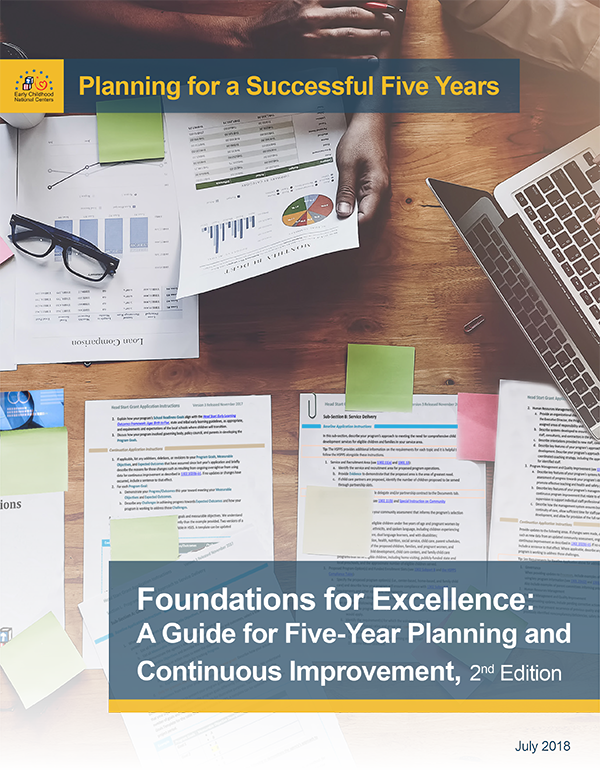How can programs use the Foundations for Excellence: A Guide for Five-Year Planning and Continuous Improvement, 2nd Edition?
 Foundations for Excellence, 2nd Edition highlights how sound planning practices support effective Head Start programs and shows programs what Head Start expects from strategic planning. Study each topic with an eye to how it can support your program throughout the planning process. Here are some ideas for making the most of this guide. Use them to spark discussion, establish a shared understanding of key concepts, and identify ideas that need further exploration.
Foundations for Excellence, 2nd Edition highlights how sound planning practices support effective Head Start programs and shows programs what Head Start expects from strategic planning. Study each topic with an eye to how it can support your program throughout the planning process. Here are some ideas for making the most of this guide. Use them to spark discussion, establish a shared understanding of key concepts, and identify ideas that need further exploration.
- Support the development of both the baseline and continuing Head Start grant applications. As a companion to the Head Start Grant Application Instructions, Foundations for Excellence, 2nd Edition supports programs in writing successful grant applications. Topic 1 highlights the vocabulary you will need to use. Topic 4 models how to use it. Throughout this guide there are tips and strategies for implementing systems thinking and organizational change.
- Evaluate and measure current program goals and objectives. Topic 1: Nuts and Bolts of Strategic Planning and Topic 3: Achieving Program Goals That Support Child and Family Outcomes highlight key vocabulary and provide useful ideas for evaluating program goals, measurable objectives, and action plans. Focus especially on writing SMART objectives. Note in particular the “M” in SMART, which stands for “measurable.” The grant application instructions require programs to report on their progress in each continuation application, and you can only point to progress on something you’ve measured.
- Set program goals, write objectives and outcomes, and develop action plans. Topic 3 will help program staff recognize the relationship between goals and objectives. It describes how to keep goals alive and how program goals, including school readiness goals, intersect to ensure comprehensive, high-quality services. Topic 4: Pulling It All Together provides samples of program goals and measurable objectives and further connects the goals and objectives to an action plan. Both topics model how programs can use the planning forms provided in the appendices.
- Plan and conduct leadership training related to oversight roles of the governing body/Tribal Council and Policy Council. HSPPS 45 CFR §§ 1301 and 1302 outline the responsibilities of Head Start program leadership (e.g., governing body/Tribal Council, Policy Council, and key management staff) in overseeing and participating in the program planning process. Topics 1 and 2 unpack these concepts and discuss the key responsibilities around the program planning cycle. This will support leadership as they develop, plan, and evaluate their programs during the five-year project period. Discuss this guide with your leadership team to arrive at a shared understanding of the information and how best to proceed.
- Discuss community assessment results with your program’s management team. Topic 2: Five-Year Planning in Head Start, describes how to use strategic planning tools, such as the community assessment, to envision a desired future. Topic 4 in turn models how to integrate program goals, objectives, and expected outcomes to address real-world issues. Together, these topics can help you develop and use a responsive community assessment.
- Evaluate your strategic planning process. Topic 2 supports programs as they consider ways to refresh their strategic planning process. In addition to describing key elements in the strategic planning process, it also highlights ways to rally stakeholder consensus as programs establish long-term goals.
In using this guide, consider both “effort” and “effect.” Identify the ways that you will measure progress toward achieving your program goals, objectives, and outcomes. In addition to collecting data that shows how much your program does and how frequently it does it (measures of effort), think about measures of changes in knowledge, attitudes, or behaviors (measures of effect). Measures of effect can help you understand the positive difference you are making for children and families.
Read more:
Resource Type: Article
National Centers: Program Management and Fiscal Operations
Audience: Directors and Managers
Last Updated: August 8, 2023
